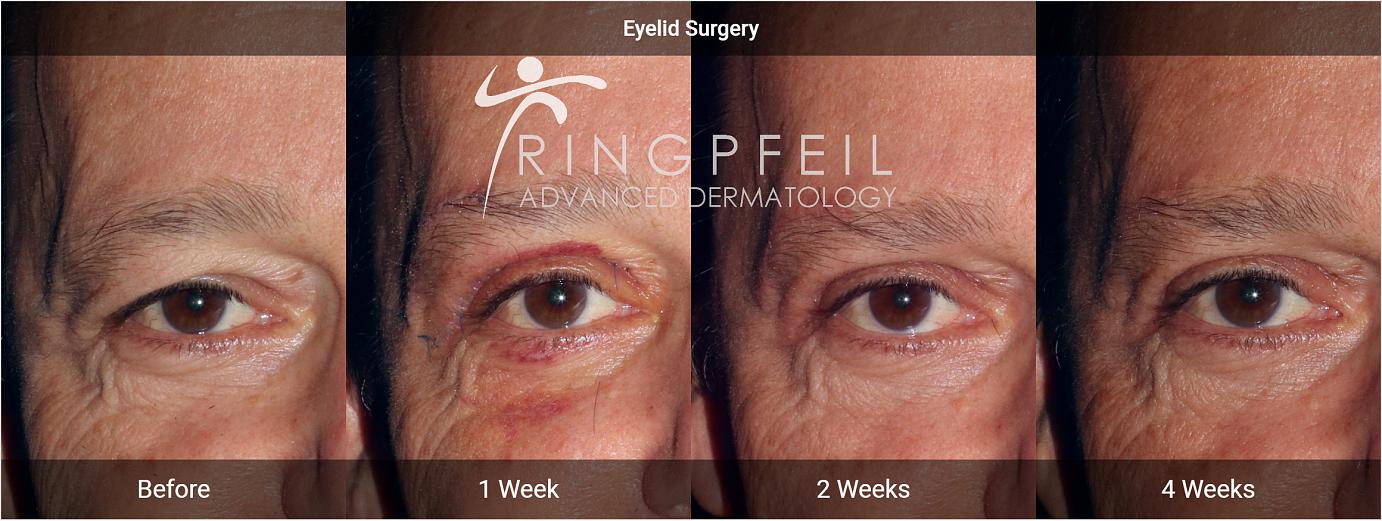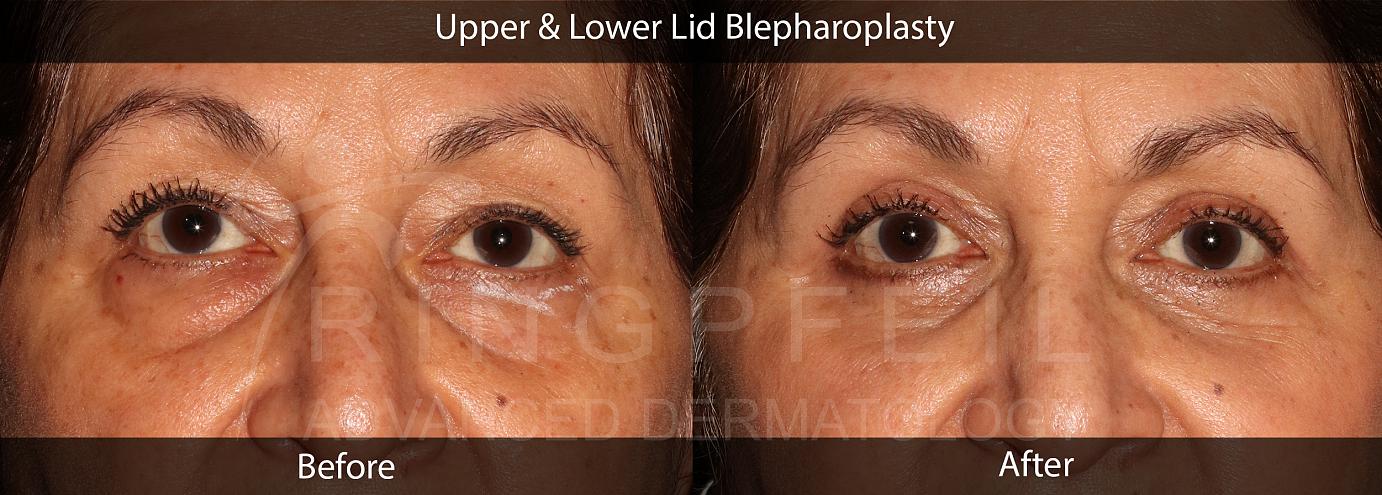
Bright, fresh, open eyes are one of the first things people notice about you. Unfortunately, the aging process causes our eyelids to droop, resulting in heavy, hooded upper eyelids and puffy bags or dark circles under the eyes.
Blepharoplasty is a surgical procedure that tightens excess sagging skin and corrects contour irregularities due to fatty protrusions to give you a more youthful look. Blepharoplasty can be performed on the upper or lower eyelids, or both can be addressed during the same procedure.
As a specialist, Dr. Krausz offers a range of effective treatments and procedures to refresh your eyes, tighten and smooth your skin, and restore a more vibrant appearance.
Upper and Lower Lid - Before & After
Insurance Coverage
Insurance may cover eyelid surgery when vision is compromised.Eyelids And The Signs Of Aging
The delicate eyelid skin is the thinnest in our body and often the first to show visible signs of aging. These signs include:
- Hooding of the upper eyelids
- Wrinkly skin
- Under-eye bags
- Eyelid hollowing
- Dark circles under the eyes
- Impaired vision due to sagging, excess skin

Our Unique Protocol
We frequently combine blepharoplasty with resurfacing CO2 laser and facial fat transfer to improve crepey skin and smoothen the transition between the eyelids and cheeks.Upper Blepharoplasty / Upper Eyelid Surgery
An upper blepharoplasty is a surgical procedure to remove excess upper eyelid skin that causes hooding of the upper eyelids. Patients often complain that they cannot wear makeup, their eyes look smaller and they appear tired. An upper blepharoplasty will correct these concerns.

Procedure Details
An upper blepharoplasty is an in-office
procedure performed under local
anesthesia. The procedure takes between 30-60
minutes.
The amount of skin to be removed is carefully marked in an upright position and then rechecked with the patient reclined to ensure that the eyes will close without difficulty after surgery.
A local anesthetic is injected under the skin and incisions are carefully placed in the eyelid crease to hide the scar. Fat pads that are normally present in the eyelids can be trimmed or repositioned to contour the eyelid for a youthful appearance.
Post-operative recovery
For the first 48 hours after surgery - Patients are instructed to apply ice to the eyelids for 20 minutes every hour while awake, rest and keep the head elevated. The early phases of recovery may include swelling, bruising but minimal discomfort.
6-7 days after surgery - Patients return to the office for examination and suture removal.
2-3 days after surgery - Patients can usually return to regular daily activities, but exercise and strenuous activity should be avoided until after the first post-operative visit.
During your visit you will receive more detailed post-opferative instructions.

Do I also need a Brow Lift?
The eyebrow and the upper eyelids are a unit and should be analyzed together. As we age, the tail of the eyebrow tends to drop and exaggerates the appearance of hooded skin in the outer portion of the eyelid. In these patients, blepharoplasty alone may not be corrective. Combining blepharoplasty with a brow lift will brighten and open the eyes and restore a natural brow arch.
Lower Blepharoplasty / Lower Eyelid Surgery

A lower blepharoplasty is a surgical procedure to eliminate lower eyelid bags, address hollowness, reduce dark circles and improve sagging skin. It is usually performed using local anesthesia and light sedation.
While upper blepharoplasty primarily addresses excess skin, lower eyelid surgery is more multifaceted. Depending on the patient's individual needs, it may involve removal and/or repositioning of the lower eyelid fat (the bags), removal of the excess eyelid skin, eyelid tightening, or a combination of these

Procedure Details
Incisions are usually made inside the eyelid with no visible dermal scars (transconjunctival approach). This approach minimizes the risk of complications associated with the older method of going through the skin. Bulging fat pads are removed or repositioned to fill hollows that contribute to the appearance of dark circles. The procedure takes between 1-2.5 hours, depending on what is being done.
When skin laxity is also present, it is often addressed with either CO2 laser resurfacing or a tightening procedure. In the latter, the incision is placed just below the lashes, and a conservative amount of skin is removed. This is done without changing the shape or position of the lower eyelid. In patients with pre-existing eyelid laxity, a canthal suspension procedure (canthopexy) is performed to support the eyelid and prevent possible short or long-term complications. It is noteworthy that the normal smile lines will still be present after skin tightening and are amenable to further improvement with neuromodulator (Botox) treatments.
Post-operative recovery
0-48 hours after surgery - Patients are instructed to apply ice to the eyelids for 20
minutes every hour while awake, rest and keep the head elevated.
0-2 weeks - Swelling and bruising are variable and expected.
2-3 days - Patients can usually return to regular daily activities. Exercise and
strenuous activity should be avoided until after the first post-operative visit.
6-7 days - Patients return to the office for examination and suture removal.

Fat Transfer & Eyelid Surgery
Facial fat transfer can go by several names, including facial fat grafting and facial fat injections. The procedure involves taking fat from one area of the body and processing it into smooth micro and nano fat. This fat can then be injected into the face to volumize hollow facial areas or be used to smooth facial lines and wrinkles, particularly of the thin eyelid skin. The fat transfer works as a natural filler with long-lasting results. Fat transfer can be performed at the time of lower blepharoplasty or as a stand-alone procedure.
Fat Transfer Procedure
The first step involves the removal of fat, called harvesting. The fat is removed through a very small incision from an area with an excess of fat, including the abdomen, flanks, or thighs. The fat is removed with a blunt long tube called a cannula specifically designed to gently obtain small particles of fat. Next, the fat is purified, cleaned and then processed through filters to create micro and nano fat. Fat of different particle size is injected into the desired areas with a small cannula.
The advantage of micro and nano-fat is greater fat survival, improved predictability, and less post-procedure inflammation. It has a smooth consistency with less risk of lumps, especially under the thin lower eyelid skin.







